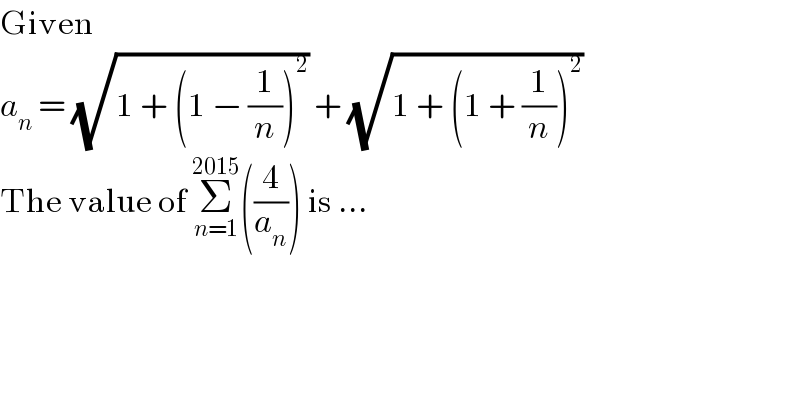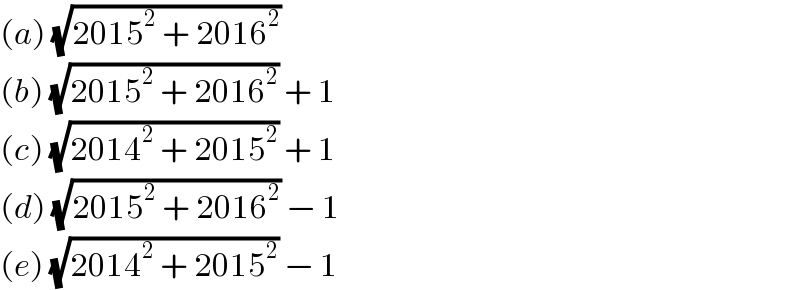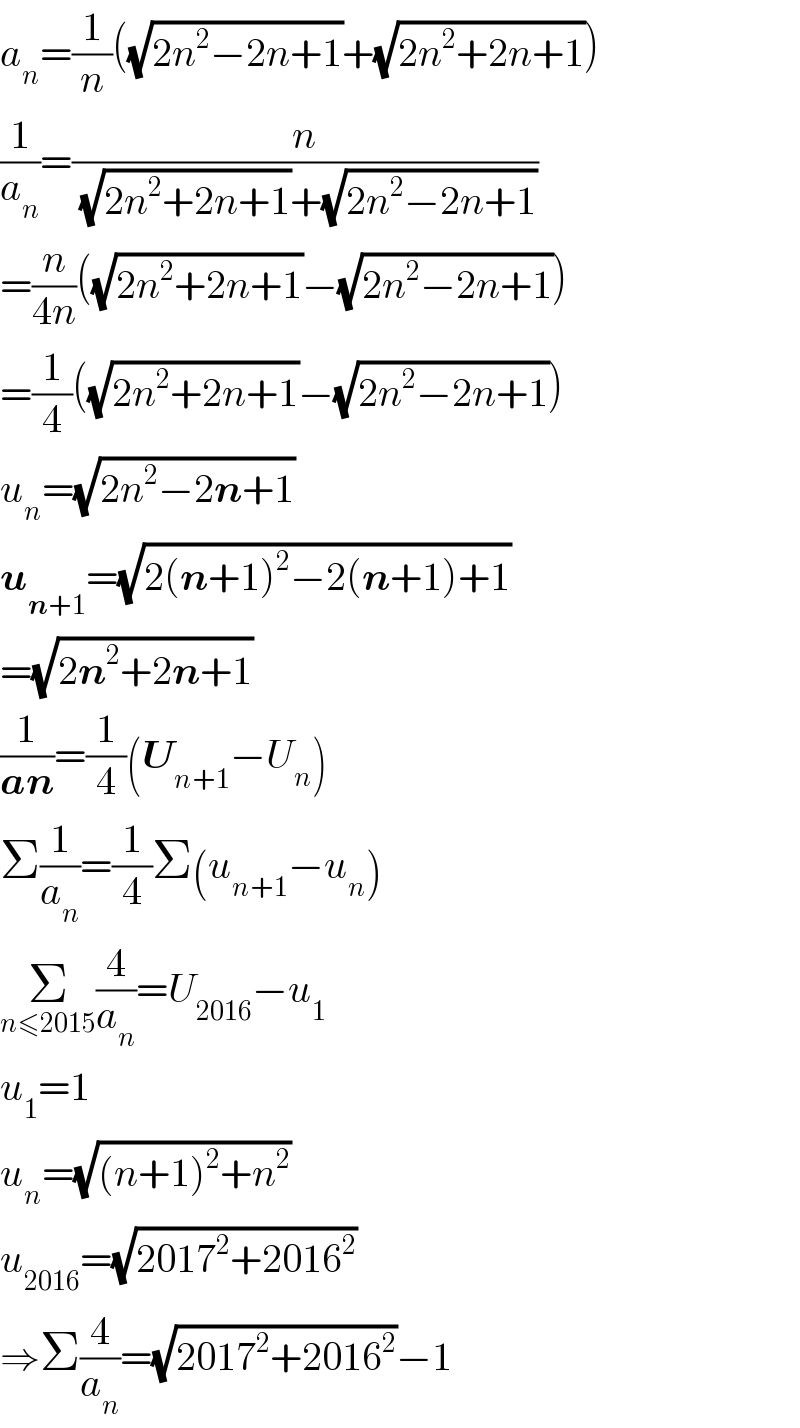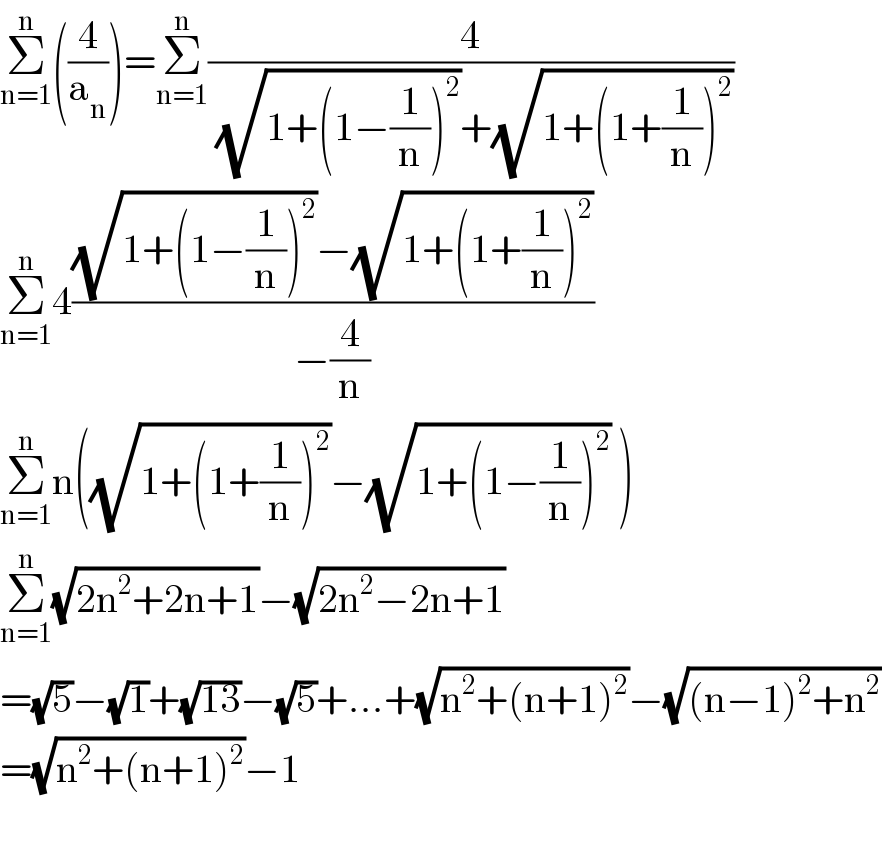
Question Number 115897 by Joel574 last updated on 29/Sep/20

$$\mathrm{Given} \\ $$$${a}_{{n}} \:=\:\sqrt{\mathrm{1}\:+\:\left(\mathrm{1}\:−\:\frac{\mathrm{1}}{{n}}\right)^{\mathrm{2}} }\:+\:\sqrt{\mathrm{1}\:+\:\left(\mathrm{1}\:+\:\frac{\mathrm{1}}{{n}}\right)^{\mathrm{2}} } \\ $$$$\mathrm{The}\:\mathrm{value}\:\mathrm{of}\:\underset{{n}=\mathrm{1}} {\overset{\mathrm{2015}} {\sum}}\left(\frac{\mathrm{4}}{{a}_{{n}} }\right)\:\mathrm{is}\:... \\ $$
Commented by Joel574 last updated on 29/Sep/20

$$\left({a}\right)\:\sqrt{\mathrm{2015}^{\mathrm{2}} \:+\:\mathrm{2016}^{\mathrm{2}} } \\ $$$$\left({b}\right)\:\sqrt{\mathrm{2015}^{\mathrm{2}} \:+\:\mathrm{2016}^{\mathrm{2}} }\:+\:\mathrm{1} \\ $$$$\left({c}\right)\:\sqrt{\mathrm{2014}^{\mathrm{2}} \:+\:\mathrm{2015}^{\mathrm{2}} }\:+\:\mathrm{1} \\ $$$$\left({d}\right)\:\sqrt{\mathrm{2015}^{\mathrm{2}} \:+\:\mathrm{2016}^{\mathrm{2}} }\:−\:\mathrm{1} \\ $$$$\left({e}\right)\:\sqrt{\mathrm{2014}^{\mathrm{2}} \:+\:\mathrm{2015}^{\mathrm{2}} }\:−\:\mathrm{1} \\ $$
Answered by mindispower last updated on 29/Sep/20

$${a}_{{n}} =\frac{\mathrm{1}}{{n}}\left(\sqrt{\mathrm{2}{n}^{\mathrm{2}} −\mathrm{2}{n}+\mathrm{1}}+\sqrt{\mathrm{2}{n}^{\mathrm{2}} +\mathrm{2}{n}+\mathrm{1}}\right) \\ $$$$\frac{\mathrm{1}}{{a}_{{n}} }=\frac{{n}}{\:\sqrt{\mathrm{2}{n}^{\mathrm{2}} +\mathrm{2}{n}+\mathrm{1}}+\sqrt{\mathrm{2}{n}^{\mathrm{2}} −\mathrm{2}{n}+\mathrm{1}}} \\ $$$$=\frac{{n}}{\mathrm{4}{n}}\left(\sqrt{\mathrm{2}{n}^{\mathrm{2}} +\mathrm{2}{n}+\mathrm{1}}−\sqrt{\mathrm{2}{n}^{\mathrm{2}} −\mathrm{2}{n}+\mathrm{1}}\right) \\ $$$$=\frac{\mathrm{1}}{\mathrm{4}}\left(\sqrt{\mathrm{2}{n}^{\mathrm{2}} +\mathrm{2}{n}+\mathrm{1}}−\sqrt{\mathrm{2}{n}^{\mathrm{2}} −\mathrm{2}{n}+\mathrm{1}}\right) \\ $$$${u}_{{n}} =\sqrt{\mathrm{2}{n}^{\mathrm{2}} −\mathrm{2}\boldsymbol{{n}}+\mathrm{1}} \\ $$$$\boldsymbol{{u}}_{\boldsymbol{{n}}+\mathrm{1}} =\sqrt{\mathrm{2}\left(\boldsymbol{{n}}+\mathrm{1}\right)^{\mathrm{2}} −\mathrm{2}\left(\boldsymbol{{n}}+\mathrm{1}\right)+\mathrm{1}} \\ $$$$=\sqrt{\mathrm{2}\boldsymbol{{n}}^{\mathrm{2}} +\mathrm{2}\boldsymbol{{n}}+\mathrm{1}} \\ $$$$\frac{\mathrm{1}}{\boldsymbol{{an}}}=\frac{\mathrm{1}}{\mathrm{4}}\left(\boldsymbol{{U}}_{{n}+\mathrm{1}} −{U}_{{n}} \right) \\ $$$$\Sigma\frac{\mathrm{1}}{{a}_{{n}} }=\frac{\mathrm{1}}{\mathrm{4}}\Sigma\left({u}_{{n}+\mathrm{1}} −{u}_{{n}} \right) \\ $$$$\underset{{n}\leqslant\mathrm{2015}} {\sum}\frac{\mathrm{4}}{{a}_{{n}} }={U}_{\mathrm{2016}} −{u}_{\mathrm{1}} \\ $$$${u}_{\mathrm{1}} =\mathrm{1} \\ $$$${u}_{{n}} =\sqrt{\left({n}+\mathrm{1}\right)^{\mathrm{2}} +{n}^{\mathrm{2}} } \\ $$$${u}_{\mathrm{2016}} =\sqrt{\mathrm{2017}^{\mathrm{2}} +\mathrm{2016}^{\mathrm{2}} } \\ $$$$\Rightarrow\Sigma\frac{\mathrm{4}}{{a}_{{n}} }=\sqrt{\mathrm{2017}^{\mathrm{2}} +\mathrm{2016}^{\mathrm{2}} }−\mathrm{1} \\ $$
Commented by Joel574 last updated on 30/Sep/20

$${Thank}\:{you}\:{very}\:{much} \\ $$
Answered by Dwaipayan Shikari last updated on 29/Sep/20

$$\underset{\mathrm{n}=\mathrm{1}} {\overset{\mathrm{n}} {\sum}}\left(\frac{\mathrm{4}}{\mathrm{a}_{\mathrm{n}} }\right)=\underset{\mathrm{n}=\mathrm{1}} {\overset{\mathrm{n}} {\sum}}\frac{\mathrm{4}}{\:\sqrt{\mathrm{1}+\left(\mathrm{1}−\frac{\mathrm{1}}{\mathrm{n}}\right)^{\mathrm{2}} }+\sqrt{\mathrm{1}+\left(\mathrm{1}+\frac{\mathrm{1}}{\mathrm{n}}\right)^{\mathrm{2}} }} \\ $$$$\underset{\mathrm{n}=\mathrm{1}} {\overset{\mathrm{n}} {\sum}}\mathrm{4}\frac{\sqrt{\mathrm{1}+\left(\mathrm{1}−\frac{\mathrm{1}}{\mathrm{n}}\right)^{\mathrm{2}} }−\sqrt{\mathrm{1}+\left(\mathrm{1}+\frac{\mathrm{1}}{\mathrm{n}}\right)^{\mathrm{2}} }}{−\frac{\mathrm{4}}{\mathrm{n}}} \\ $$$$\underset{\mathrm{n}=\mathrm{1}} {\overset{\mathrm{n}} {\sum}}\mathrm{n}\left(\sqrt{\mathrm{1}+\left(\mathrm{1}+\frac{\mathrm{1}}{\mathrm{n}}\right)^{\mathrm{2}} }−\sqrt{\mathrm{1}+\left(\mathrm{1}−\frac{\mathrm{1}}{\mathrm{n}}\right)^{\mathrm{2}} }\:\right) \\ $$$$\underset{\mathrm{n}=\mathrm{1}} {\overset{\mathrm{n}} {\sum}}\sqrt{\mathrm{2n}^{\mathrm{2}} +\mathrm{2n}+\mathrm{1}}−\sqrt{\mathrm{2n}^{\mathrm{2}} −\mathrm{2n}+\mathrm{1}} \\ $$$$=\sqrt{\mathrm{5}}−\sqrt{\mathrm{1}}+\sqrt{\mathrm{13}}−\sqrt{\mathrm{5}}+...+\sqrt{\mathrm{n}^{\mathrm{2}} +\left(\mathrm{n}+\mathrm{1}\right)^{\mathrm{2}} }−\sqrt{\left(\mathrm{n}−\mathrm{1}\right)^{\mathrm{2}} +\mathrm{n}^{\mathrm{2}} } \\ $$$$=\sqrt{\mathrm{n}^{\mathrm{2}} +\left(\mathrm{n}+\mathrm{1}\right)^{\mathrm{2}} }−\mathrm{1} \\ $$$$ \\ $$
Commented by Joel574 last updated on 30/Sep/20

$${Thank}\:{you}\:{very}\:{much} \\ $$
